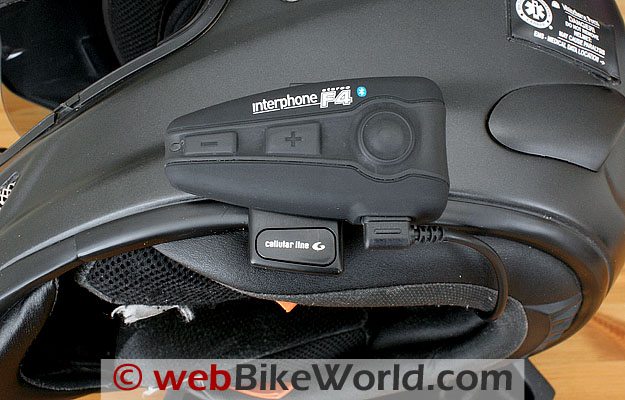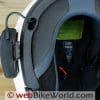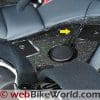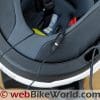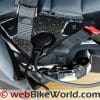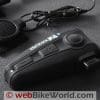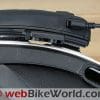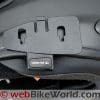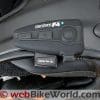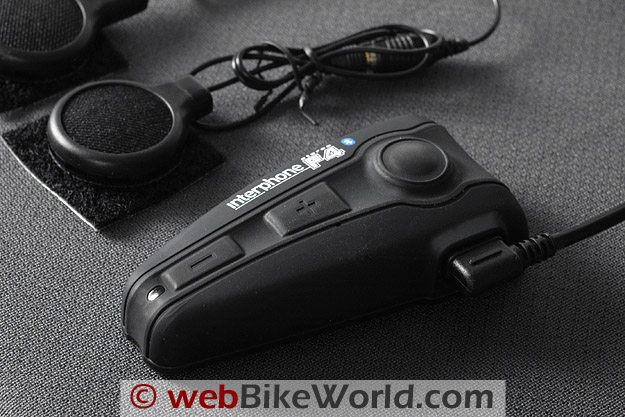Interphone F4 Bluetooth Intercom Review
I concur with the Part 1 conclusion.
The Interphone F4 is easy to use and it has outstanding sound and volume.
It also pairs with anything Bluetooth.
The IP-67 waterproof rating is a worthy exclusive; it is very reasonably priced for what you get and it’s a contender for the title of “Best New System”.
This is the Part 2 follow-up for the Interphone F4 Bluetooth intercom.
We now have a Part 1 and Part 2 for the three most recent generation of Bluetooth motorcycle intercom systems, the Sena SMH10 (Part 1 and Part 2), the Cardo Scala Rider G4 (Part 1 and Part 2) and this, the Interphone F4 (Part 1).
The final report in this series will compare, score and rate each of these systems.
These three systems represent the latest generation of Bluetooth motorcycle intercoms.
They are feature-rich and provide much better performance than any of the previous generation of Bluetooth intercoms we have reviewed.
It is very difficult to choose a “winner” among these three, as each intercom has a slightly different performance emphasis. It may come down to availability, price or which feature is most important to you.
It’s important to note that there is still room for improvement for motorcycle Bluetooth intercom systems.
webBikeWorld readers have been asking for features such as standardization that would allow brand-to-brand interoperability and communications.
Also the ability to simultaneously communicate with multiple intercom units and other Bluetooth devices; auxiliary input ports; easily replaceable speakers; removable batteries and, as always, smaller and lighter modules and headsets.
As with any modern technology, the rate of evolution for motorcycle Bluetooth intercom systems is extremely rapid, so hopefully your wishes will come true sooner rather than later!
Introduction
First off let me be up front: I consider the Interphone F3 Intercom review back in January 2007 to be the first (really) useable rider to rider helmet system.
Its range of over 500 meters was impressive then and compared to some other less than stellar offerings on the market today, despite technology advances, it still is…progress eh?
While the original Canadian distributor has moved on to other things, the Interphone is back with us, now in F4 guise and needless to say I was eager to get my hands on the new systems.
As way of follow-up to information provided in Part One of the Interphone F4 review regarding Interphone nomenclature for their different intercom models, I found out this:
The “F2” designation is used for the Interphone F2 City, a rider-only headset that provides basic Bluetooth connectivity for mobile phones and navigation audio along with an auxiliary 3.5 mm stereo plug for music connectivity.
The Interphone “F3” designation identified in Part One is now used for the Interphone F3 Passenger kit. That system has features similar to the F4 but its intercom is tailored for short-range rider communication with rider-to-passenger capabilities.
So that brings us to the Interphone F4.
A loaner set of F4s, identical to the ones originally reviewed (another story for another day) by Rick and Burn made their way northward to me for this slightly abbreviated Ride Report and Part 2 Follow-up posting.
But how does the F4 intercom system compare?
Well, during the time I had the F4 systems they got a thorough workout, especially on a daily basis to keep one of my phones paired for emergency and work contact purposes and for on-going communications via the intercom.
Part One covered the basic ground in excellent fashion and since it was published, more than a few comments have been posted and the Editor has sent a few questions along to me for further feedback and discussion.
Accordingly, the objectives for this Part 2 Follow-up report are two-fold: provide further insight into the Interphone F4 system and address some of the questions posed.
So, what did I do once the systems were received, inspected and charged up? What I normally do — give them a dry run and then install them in helmets, so here we go.
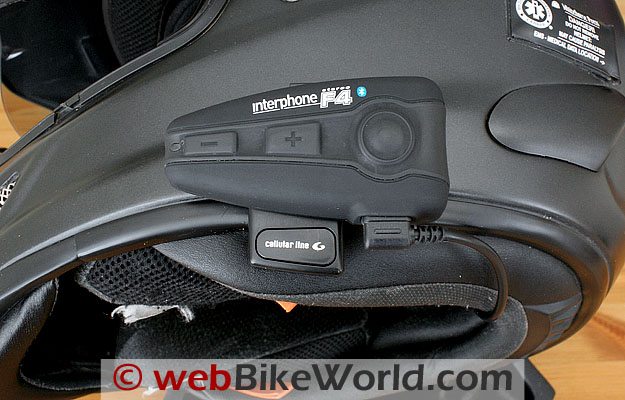
Helmet Installation
Both systems are the universal fit version with the boom-type microphone. First up for installation would be the Nolan N103 helmet (review), but as the loaner F4 units would be heading back down south I opted not to use the supplied adhesive slide support (identified in the manual as the ‘mounting plate’).
So I unscrewed the clip that normally slides up between the helmet shell and liner from the removable slide support, revealing the inner face. This surface is covered with a soft plastic material that acts as a non-skid protective cushion against the outer helmet shell when the complete headset is mounted.
For simple and expedient mounting of multiple helmet systems the Nolan helmets already sport large 3M Dual Lock fastener templates to their outer shell, so it is a simple matter to mount two rectangular companion pieces of the fastener to the plastic material on the slide support and “snap” it securely to the helmet.
Despite sitting 3 mm farther out than if using the supplied adhesive, the F4 headset is very much at home on the Nolan.
The speakers are ideally sized for use in the Nolan N103 and after creating a small recess in the left side foam liner to accommodate the shape of the speaker/boom microphone assembly, the left speaker nestles perfectly in its provided recess.
The boom of the microphone finds support in the existing channel on the N103 and the right side speaker mounts in the recess already provided in the Nolan. Not that it is hard to go wrong here; the speaker recesses in the hard foam liner and matching cutouts in the removable inserts ensure optimal placement of the audio components.
Tip: if a companion piece (preferably round) of fastener material is used to secure the speakers in the recess, it is best to take a bit of time and cut a few small holes in the fastener that will match the pattern of the three ports found in the hard foam recess — this tends to improve bass response…
And for the absolute best efficiency, some may want to move the speakers out slightly closer to the ear.
The whole placement effort is worth it — better audio with less volume is the typical result. Just don’t forget to factor in your ear protection (Note: ear plugs are always used when evaluating motorcycle intercom speaker systems).
On the flip side, using the clamp slide support to secure the system to the full-face Arai XD3 (review) and Arai Corsair (review) helmets is simple, but the result is not as clean or effective as with the Nolan.
Although the right side speaker mounts easily due to the in-line 2.5 mm audio connector, the integrated left speaker/boom microphone assembly proves problematic.
To get the microphone on its short boom even close to the mouth area, the left speaker has to sit forward of the ideal spot in the removable check pad, so a compromise is needed right from square one.
Running the boom out through the strap cutout positions the foam microphone cover just at the left side of the mouth.
I just wish more industry players would follow the Cardo lead in providing extended boom systems as found on the Scala Rider MultiSet Q2 (review), or go to modular headset components.
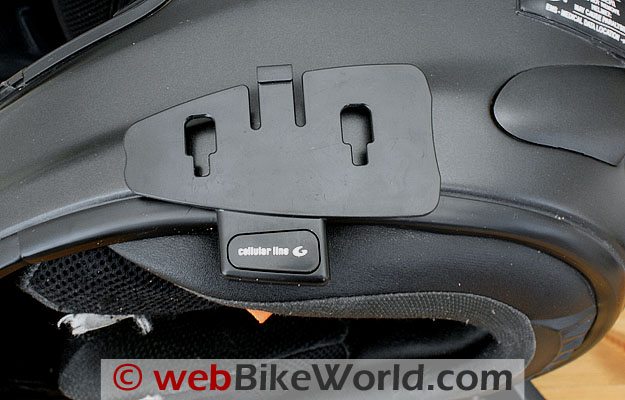
Pairing the Interphone F4
As noted in Part One, the F4 had no issues when finding and pairing up with other devices offered up and my findings don’t change the original assessment at all.
My basic test suite of Bluetooth-enabled devices or peripherals that I use for all my communications system evaluations and for daily use is as follows:
- Bluetooth Adapters (BTA): AKE BTD-302 Audio Adapter; the Chatterbox iCombi AG-12 and AP-21 Bluetooth Adapter (review); IMC Camos BH-200M Bluetooth Adapters in stereo and mono; Albrecht BPA 100 Bluetooth Adapter; wiREVO Bluetooth Headphones and Adapter; and the Rocket Fish MBT30 (review pending).
- Mobile Phones: Multi-function HTC Touch and Kyocera X-tc devices and the more basic LG5500, LG LX165 and Motorola i335 mobile phones.
- GPS Navigation Devices: Garmin zumo 550; Garmin zumo 660 (review); BMW Navigator III+ (info) and the new zumo 665 with all its accessories (review pending).
From a Bluetooth Adapter perspective, one thing to remember is that when using standard iPod multi-pin connector adapters like the iCombi AP 21 and Rocket Fish MBT30, audio output via this connection is fixed (i.e., constant output level), so volume can only be adjusted via the headset controls.
On the other hand, when the peripheral is connected by wire to a Bluetooth Adapter that is acting as the wireless host for streaming audio to the headset, volume controls on either the headset or paired peripheral can be used.
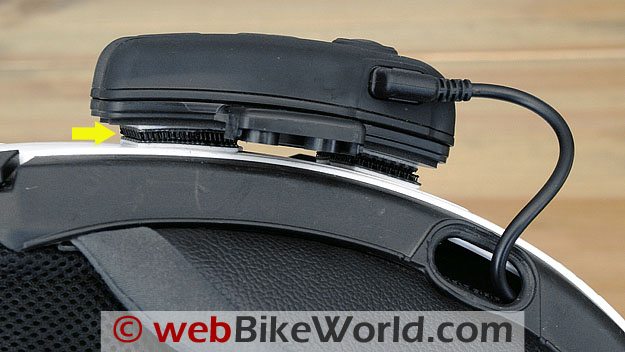
Interphone F4 “DualPhone” Feature
The telephone + telephone feature, known as “DualPhone”, works well but depending on which cell phones are used, the results can be mixed.
I purposefully tried different combinations using the five mobile phone devices listed above; the feature works with them all but it is less than seamless, although the phones themselves may not be completely innocent.
While the manual seems to contradict itself regarding DualPhone priorities, I found that unless the multi-function button is actually pressed, the first call is not interrupted.
Also, the system does not switch audio to the second device, although a very short time-out does occur that probably represents the headset attempting to sort everything out. Your results, of course, may be different.
While this feature may be relevant to some users, it also makes me want to get up on my soapbox (milk carton) and voice a small rant about consumers, including motorcyclists, who absolutely, positively, need to have more than one communications device available or active at one time.
It is incredulous the things one sees being done by road users.
The Interphone F4 owner’s manual expresses my sentiments well: “Always prioritize your riding, not telephone calls.” Enough said.
The Interphone F4 Intercom and GPS: Notes
I am lucky in having four motorcycle navigation devices on hand and access to other models as needed.
But as of late, getting the systems and devices paired up has been pretty boring because everything typically works so well! Note that I said “typically”.
The Garmin zumo 665 and 660 found and identified the “Interphone F4” device in five seconds or so and with partnerships established automatically, mono navigation and stereo music audio is pushed from the devices to the headsets in short order.
There is a slight switching delay, sometimes accompanied by a burst of white noise (hissing) when audio is switched between devices/profiles, an issue probably related to the “short time-out” experienced when using the DualPhone feature.
I haven’t experienced a delay that is this long or this audible with any of the other motorcycle intercom headsets I have used recently, especially when employing navigation devices.
It is not a big detraction however, and the issue is actually acknowledged in the Interphone F4 Instruction Manual.
In a three way configuration with the headset with navigation device hosting a mobile phone, the zumo models successfully supported the standard mobile phones using the headset profile and all basic phone features were available via the zumo mobile phone application menu.
Multi-function devices typically do not always work well when hosted by a zumo unless paired via the “Phone” feature or by actually de-selecting or disabling the “Stereo Headset” option on the device.
These potential conflicts — also known as exercises in frustration — can often be mitigated by first rationalizing how peripherals will be used especially when using navigation or other multi-function devices that support both “Audio” and “Phone” options for audio pairings.
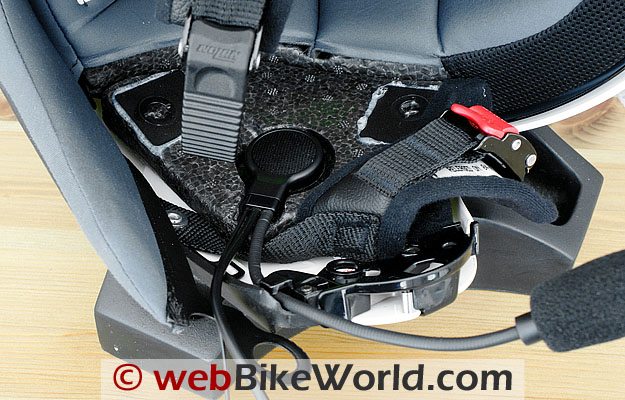
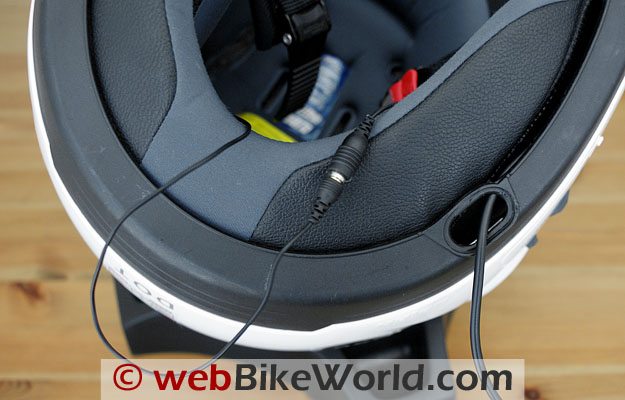
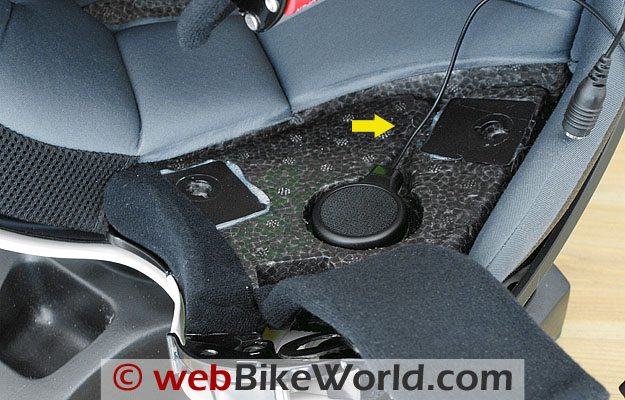
On the Road: Using the Interphone F4 Intercom
Many of you know by now where my priority lies for a Bluetooth helmet system: the intercom. If the intercom doesn’t work well, then the system is usually between a rock and a hard place with me…objectively speaking of course.
Intercom setup with the Interphone F4 is ho-hum easy. With both systems off, press and hold their multi-function buttons for about eight seconds to initiate pairing mode. When both sets are flashing the familiar alternating red and blue LED pattern, press the multi-function button on one unit. A few seconds later the LEDs go to a steady blue state — all done.
If pairing an Interphone F4 with an older Interphone intercom, the initiation sequence is the same, but once they’re paired, the older Interphone intercom’s LED will flash a rapid blue, while the F4 LED will remain a constant blue. Just remember that the intercom range will be limited to that of the earlier generation device.
I didn’t actually break out the measuring tape, but the Interphone F4 really does have a very impressive intercom reach. Direct line of sight in a typical residential environment didn’t result in any dropped sessions even out to six or seven long blocks.
On the road (riding, not standing in the middle of it!), typical operating range is right around 1000 metres or 3,280 feet (one kilometre = 0.62 mile). This is impressive, but not unexpected and it intrudes into the exclusive territory covered by the Sena SMH-10 system (review).
The resultant Interphone F4 audio however is not of the same consistent quality provided by the Sena. The automatic gain control in the F4 does a good job of maintaining or averaging out audio across a wide noise baseline, but at times it is obvious under or over-reacting to ambient noise levels and ongoing audio input.
As intercom range stretches out close to maximum, volume goes way down and audio, while still understandable, is degraded, probably on the order of 10 to 20 percent. Once the separation distance is back in the 600 to 750 metre range, all is well. Are we getting spoiled? I think so.
I also observed that once the link was lost it would not auto-restore when the systems were brought back in to close proximity and the second system usually got the three-tone end of session signal.
So it seems the Interphone F4 intercom is terminating a lost session rather than allowing the lead system to go into scanning mode…
Virtually all of the newer systems evaluated over the last year or so are so good at restoring the intercom that experiencing this issue with the F4 was a surprise.
Manually starting another session quickly activates the intercom again, but I am a bit disappointed in what should be a standard and reliable feature. Having said this, I realize that this may be a default setting used to help conserve system power as active search/scanning modes all consumer power.
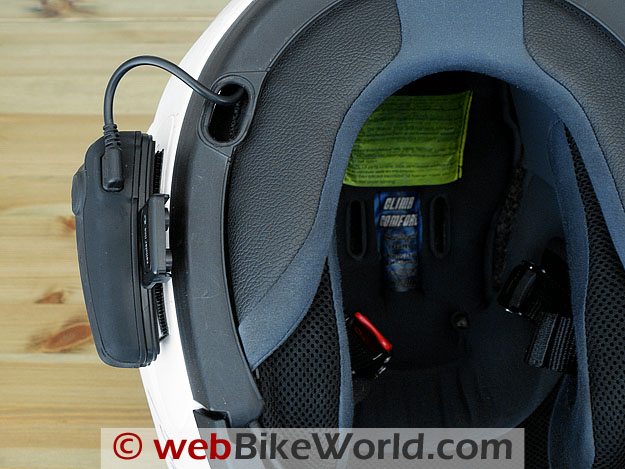
Other Observations
Waterproof to IP67: Something that is obviously up to the task is the weather protection skin membrane covering the Interphone F4 modules.
The Interphone F4 is the only intercom module we know of that has undergone IP testing and is certified to IP67 (IP6 = “Dust Tight” and IP7 = “Immersion up to 1 metre”).
The emphasis on water resistance may be a result of the European origins of Interphone, as European weather can be a bit iffy in some regions.
The outer sheath completely encases the intercom module except for the connection port, and as long as the headset connector is properly seated, waterproof integrity is maintained. I managed to expose both units to several days of prolonged and heavy wet-weather use and they survived just fine.
Equally as impressive as intercom range is the connectivity reach between headsets and paired Bluetooth devices.
I can be 15 metres (50 feet) or even more away from a paired device while wearing the helmet with headset and receive noise-free mono or stereo audio. For a device that uses Bluetooth Class Two power for device pairings it is extremely effective.
Battery Life: Battery life or duty cycle time is also outstanding. I typically saw ten to twelve hours of heavy intercom and two to three hours of intermittent music streaming from a single charge. When using it just for phone monitoring the system would last for almost three full days of riding.
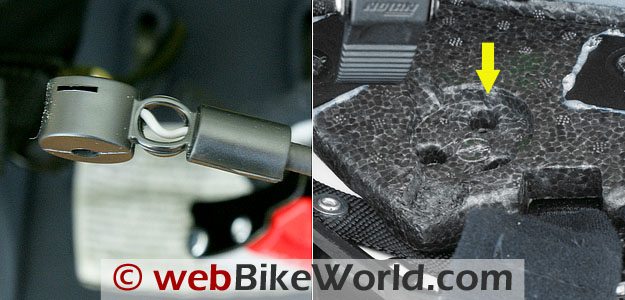
| Interphone F4 Bluetooth Intercom wBW Bottom Line Ratings | ||
|---|---|---|
| Feature | Rating | Comments |
| Packaging | Not Rated | Having received the loaners from the Editor in a plain brown box, I cannot comment directly on the original packaging from my perspective. |
| Design | Excellent | Streamlined shape; pleasing to the eye. Minimalist controls blend into the overall look and feel of the module, all enhanced by the waterproof skin.The single port is well recessed, the interface connection well protected. Mounting assembly is strong but lightweight. Locking lever is a bit lightweight. |
| Execution | Excellent | Tactile controls are easy to find and use with light to medium-weight gloves, more difficult with cold-weather gear. The waterproof skin feature is seamless and despite its smoothness offers great grip for handling.Weak point – the locking lever is “OK” at keeping the Bluetooth module seated, but it will release if bumped or pushed hard from the bottom.
Another concern: while a solid (tight) fit between interface connector and port is necessary to keep the system waterproof, getting it pushed in and pulled out takes a fair bit of effort and the connector itself doesn’t offer much grip: repeated use may weaken the elbow joint unless the user takes care. A short ribbed extension for grip would really help here. |
| Features and Performance | Excellent to Outstanding | The F4, like its predecessors, has the basics. But it still takes a hit here (comparatively) in not having an auxiliary stereo input port. Design, cost and certification concerns are all relevant, but at the end of the day, it is still missing…Performance is outstanding. For the features is has, the F4 does not disappoint.
Even with the observations regarding some audio degradation and (probable) lack of a restoral routine in the intercom, the F4 is an outstanding system that exhibits the same high performance levels established by the original Interphones. |
| Intercom | Outstanding | The communication range of the F4 is right up there with my current link champion, the Sena SMH10. But the F4 is still in second place due to less than seamless performance in providing consistent audio quality and in restoring the connection automatically if it is lost. |
| Multi-User Configuration | Very Good | As with its predecessors, the F4 can only pair with one other F4 or another compatible Interphone intercom unit and when used as a pair, the system works extremely well.Multi-user functionality is not provided with the current release. |
| Audio Input & Control | Excellent to Outstanding | I waffled on this one. System audio input via Bluetooth and intercom, and subsequent control of the audio is outstanding but not having an auxiliary input for a wired connection is to me a serious oversight.Within the current market place virtually all other contenders provide this feature and for good reason. |
| Audio Sharing | Not Rated | This feature is not available on the F4. Unfortunately, something that could be easy to implement has not been done.For simple sharing of music or navigation audio, especially between rider and passenger via the intercom link, this is a requirement that is still missing in action by most systems. |
| Audio Priority | Not Rated | System priority is telephone(s), navigation device, intercom and music. |
| Audio Quality | Outstanding | Close — and I mean close to the Sena headset, especially when using the Nolan N103.If the diminishing volume and restoration issues were not issues then the F4 and the Sena would be in the ring competing for the title. |
| Device Compatibility | Outstanding | Like the Cardo Scala Rider series, this latest Interphone iteration is fully compatible with its predecessors and in all likelihood its current siblings. It may seem a trivial thing to some consumers, but from an overall communications perspective, it’s not. |
| Options | Not Rated | The only options available for the Interphone F4 are replacement parts. Unlike many of the newer systems, including the G4, the Sena and others, it does not have an auxiliary input jack.Like virtually everything other system on the market, other than the optional in-ear adapter that can be used with the IMC Camos BTS 300 Bluetooth Intercom and other BTS systems, there is no ability to utilize an in-ear headset. The lithium battery cannot be replaced. |
| Fit | Very Good to Excellent | The boom style headset provides close to a perfect fit in a three-quarter or flip-style helmet, like the Nolan N103, but the boom itself is five to ten centimeters short of being optimal for most installations.The universal boom assembly in a full face helmet really brings out the shortfalls in this integrated approach. The thin-wire headset is the way to go for anything other than a three-quarter or flip-style helmet. |
| Setup and Configuration | Outstanding | Not much to comment on here — simple controls, simple functions and virtually seamless connectivity right from the start.I actually like the little F4 Pocket Guide, which can be figured out if the icons used are understood: the table becomes a quick reference conditional matrix. In reality, continued use of the F4 will negate the need for the guide. |
| Ease of Use | Outstanding | Simple to understand and simpler to use. Only heavy gloves will pose an issue in getting the Volume Up or Down the first time.The multi-function control is not a problem. Only niggling issue is the effort required to seat/remove the connection plug. |
| Power | Outstanding | Overall “active use autonomy” is really good from the F4. When all the features are being used on a rotating basis the battery will keep things going for a longish (eight to ten hour) riding day or longer if peripheral use is minimal. |
| Reliability | Outstanding | Everything worked and continued to work as advertised, even in heavy persistent rain and high winds.As my original Interphone and upgraded units are still fully capable of an honest days’ work and have endured far more abuse, I suspect the F4 units will do the distance. |
| Maintenance and Support | Excellent | Nothing required, outside of periodic charging of the modules (far less than most other systems on hand).I keep the modules wiped off and make sure the mounting components are still tight. The multi-language manual is good, albeit not error-free. |
| Cost | Excellent | At the listed price of $225.00 USD for each F4 intercom, that amounts to somewhat less than what I paid for the first original Interphone units a few years ago and given the enhancements and advancements, the F4 systems are well worth the price. |
| Value | Outstanding | Appreciating everything and factoring in a longish and positive Interphone history, the F4 systems are a smart investment, even with specific exclusions and minor issues factored in.A two year warranty always adds value and peace of mind, as does having a good distributor. |
Technical Information
- Module: BTMOTOF4.
- Release: R106.
- Bluetooth: Version 2.1 +EDR.
- Pairing: Up to eight (8) devices.
- Multipoint: Up to three (3) devices (e.g. telephone + intercom + stereo).
- Profiles: 201 Headset, Hands-free, A2DP, AVRCP and SBC (Sub-Band Codec, an audio encoder and decoder codec within the Advanced Audio Distribution Profile (A2DP).
- Range: 500 m under open field conditions (claimed).
- Battery: Lithium.
- Active use autonomy listed as up to ten (10) hours.
- Stand-by Time: Up to 700 hour.
- Recharge Time: 3 hours or less depending on battery state.
- Charging: 100-240V AC, DC output is 5.0V at 0.7A nomina.
- Dimensions: 90 x 46 x 20 m.
- Weight: 84 g (including ear phones and microphone).
Conclusion
Like the Sena SMH10 system, the Interphone F4 pleases me, a lot, and I’m pretty darn fussy — trust me.
The positives include the long-distance range for F4-to-F4 communications and also the long battery life.
The minuses are the minor intercom audio loss and the occasional problem with restoring the communication link. Also, I’d like to have an auxiliary audio input port, although this is an issue with most of the intercoms we have reviewed.
As I stated earlier, if the Interphone F4 intercom didn’t exhibit a couple of weak spots, I would really have to toss a coin to decide the winner between the F4 and the Sena SMH-10, because everything else on the F4 makes sense and works.
While the F4 may not be the most fully-featured system on the market, its design philosophy is similar to previous generation Interphone intercoms.
It focuses on basic requirements and for the most part, gets them absolutely right.
Part 1: Interphone F4 Intercom Review
Owner Comments and Feedback
See details on submitting comments.


